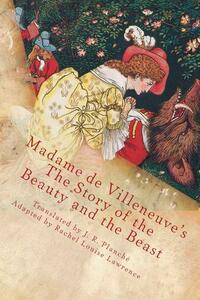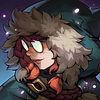Take a photo of a barcode or cover
inspiring
relaxing
fast-paced
Plot or Character Driven:
Character
Strong character development:
Complicated
Loveable characters:
Complicated
Diverse cast of characters:
No
Flaws of characters a main focus:
Complicated
adventurous
slow-paced
Plot or Character Driven:
Plot
Strong character development:
No
Loveable characters:
No
Diverse cast of characters:
No
Flaws of characters a main focus:
Yes
adventurous
lighthearted
fast-paced
Plot or Character Driven:
A mix
Strong character development:
Yes
Loveable characters:
Yes
Diverse cast of characters:
Yes
Flaws of characters a main focus:
Complicated
As many people around my age, I know Beauty and the Beast through the Disney movie. And when I came across the original, I was curious to see how different it was.
Basically, Beauty and the Beast is a fairytale - a somewhat complex story for kids. Apart from the known characters (Beauty, her father, the beast), there are actually fairies too. And the second part, the majority of the book is to explain why and how everything happened before the lover’s fate intertwined.
This was nice to read, but the way Beauty and the Beast interacted felt short and flat. Learning their background through the fairies meddling felt like a mythological story (which is a nice comparison, I think), with all the complications, and slightly higher powers, but for kids.
I find it genius, how based on this story Disney came up with such a complex and entertaining retelling, and made it all come to life. Beauty and The Beast is one of my favorite childhood movies, and now I appreciate it even more, thanks to the book.
lighthearted
relaxing
medium-paced
Plot or Character Driven:
A mix
Strong character development:
Complicated
Loveable characters:
Yes
Diverse cast of characters:
No
Flaws of characters a main focus:
Complicated
It was great to finally read the original story after enjoying so many film adaptations over the years. It's easily my favorite fairy tale thanks to the good-hearted monster theme that I love so much.
Some of the film versions have gotten close to faithfulness, but none that I've seen have captured the horror of the Beast or made him seem as stupid and wholly unlikeable as he is in the novel. Film versions anthropomorphize him and make him gruffly romantic, which I like, but the book is remarkable for giving him no redeeming qualities other than his generosity in looking after Beauty's needs.
Another huge change is that the adaptations only cover the first half of the book. I was shocked to get to the halfway point and the Beast has already turned human again. I couldn't imagine how de Villeneuve was going to finish out the story. It's not as fascinating as I thought it might be though. The second half is all prequel, explaining every detail about both Beauty and Beast's backstory. The events themselves are cool, but they're presented in a huge dump of exposition and it would take probably a whole trilogy of novels to relate them properly. I'm kind of surprised that no one's written that yet. I'd read it.
Some of the film versions have gotten close to faithfulness, but none that I've seen have captured the horror of the Beast or made him seem as stupid and wholly unlikeable as he is in the novel. Film versions anthropomorphize him and make him gruffly romantic, which I like, but the book is remarkable for giving him no redeeming qualities other than his generosity in looking after Beauty's needs.
Another huge change is that the adaptations only cover the first half of the book. I was shocked to get to the halfway point and the Beast has already turned human again. I couldn't imagine how de Villeneuve was going to finish out the story. It's not as fascinating as I thought it might be though. The second half is all prequel, explaining every detail about both Beauty and Beast's backstory. The events themselves are cool, but they're presented in a huge dump of exposition and it would take probably a whole trilogy of novels to relate them properly. I'm kind of surprised that no one's written that yet. I'd read it.
mysterious
medium-paced
Plot or Character Driven:
Character
Strong character development:
Complicated
Loveable characters:
N/A
Diverse cast of characters:
N/A
Flaws of characters a main focus:
No
Geschichte recht langatmig. Gibt auch schöner gestaltete Bücher aus der Reihe.
slow-paced
Strong character development:
No
Loveable characters:
No
Diverse cast of characters:
No
I consider myself to be a pretty big Beauty and the Beast fan but I’d never read the original story, so I was very excited to finally get my hands on the illustrated MinaLima version. But uh… I have to say I’m pretty underwhelmed? Both with the story and the graphic elements, unfortunately.
Let’s start with the story:
Let’s start with the story:
- This translation is from the 1800s, and it has the same wordy complex sentence structure that Jane Austen has. This does give the story a certain gravitas, but it’s also pretty dry at times.
- Beauty has surprising agency and intelligence! I did really enjoy that. She is well reasoned when she speaks and more practical than I expected for a fairy tale hero.
- That being said, it’s weird that all her male family members are apparently great, but the narrator makes sure to mention over and over how much her sisters suck. I guess the myth of female competition existed even in the 1700s. Also Beauty has 6 brothers and 5 sisters - I can see why retellings pare this down so much.
- Beauty goes home for a full two months - again I can see why retellings cut this down to a week or three days because that's just so much time that slows the story a bit.
- That said I do like the detail of Beauty traveling via twisting her ring on her finger - it feels much more magical than the typical horseback travel.
- The story most of us are familiar with is actually only about half the page count. The other half devolves into fairy politics and stories of hidden identity and magic. It’s somewhat interesting, but mostly jarring since this all happens AFTER Beauty and her beast get engaged and the beast transforms back. I know this was written before fairy tale story structures were modernized but man it’s an extended denouement.
- Beauty is secretly adopted? And actually cousins with the prince????
- Beauty’s adopted father owns enslaved people???????
- Also there are a lot of birds and monkeys in the palace. That is the height of enchantment, apparently. I'm not surprised this is left out of most modern interpretations because it feels really random.
- Beauty is a theater kid who spends most her time watching different plays and operas in the castle. Fun but random - I guess this could reflect what French 1700s society considered a luxury?
- There is briefly a moment where Beauty’s worthiness as the Prince’s wife is called into question since she isn’t royalty, and they try to have a moral lesson about the quality of her character being worthy enough, but then it turns out she’s secretly a princess so it’s fine and no moral is learned. And then the same lesson happens again with her mom being secretly a fairy. I thought we were going to have a really modern moral here but I guess questioning the monarchy is a bit daring for the 1700s.
- Also, despite the illustrations clearly taking heavy inspiration for the beast's look from the 1991 Disney movie, the beast is never given a clear written description - we just know he has "scales", "paws", and apparently a trunk???
And then the graphic elements:
- I really love a lot of MinaLima's work, but many of these illustrations felt underdeveloped and plain. They lacked the detail and care of the cover art.
- Often they copied and pasted the same elements multiple times in the same image which felt lazy? I don’t know what the budget or timeline for this project was but I was just expecting a bit more lavish detail from a book with a gold embossed cover that costs over $35.
- Some of the interactive elements were fun (I liked the ring that you could spin just like Beauty to go between the castle and her house! That felt plot relevant!) but most of them were unnecessary or unrelated to the book. At one point there’s a fairy book you can open but it opens to a single page that is exactly the same as the cover. Did that really need to open? Also the maps in particular were weirdly underwhelming - there are two in this book and neither of them truly look like maps so much as half-hearted tableaus.
- Also the character design was inconsistent and lacked detail or personality. Maybe that’s just not MinaLima's strength, but why illustrate a character-focused story then?
- Also there are far more illustrations in the first half of the book than the last - it almost feels like the artist got bored at the denouement just like I did, but only one of us was getting paid to read and illustrate it and I expected more embellishment in this section after the first half had almost an illustration every page. The latter had more like one illustration for every eight pages. It made it even harder to get through, which is WILD to say about a fairy tale.
- Overall the drawings and interactive elements just felt phoned in. They lacked whimsy.
I’m still glad I read this book finally, but I’m underwhelmed. I will be keeping my copy because it is nice to have the original text, but when I first got this I thought that the illustrations would be the main event and the story more of a nice extra, and this turned out to be the opposite. I guess that's the risk when you buy a book that is cling wrapped closed!
challenging
lighthearted
mysterious
medium-paced
Plot or Character Driven:
Character
Strong character development:
Yes
Loveable characters:
No
Diverse cast of characters:
No
Flaws of characters a main focus:
Yes
« Puisque vous m’aimez, je veux vivre »
Il existe de nombreuses versions de « La Belle et la Bête ». J’ai connu en premier celle des studios Disney, puis l’adaptation de Jean Cocteau en 1946 avec mon enseignant en école primaire. Encore aujourd’hui, je me souviens avoir beaucoup aimé l’atmosphère qui règne dans le film. Assez sombre et mystérieuse. Quand j’ai vu le studio MinaLima proposer leurs illustrations pour l’histoire de Gabrielle-Suzanne Barbot de Villeneuve, ces souvenirs me sont revenus, et je me suis dit qu’il serait temps de connaître la première version de « La Belle et la Bête », un conte qui me tient à cœur, comme beaucoup d’autres je suppose.
Comme c’est la première version et que celle-ci date de 1740, c’est de l’ancien français. Quand nous ne sommes pas habitués, il est normal de lire plusieurs fois la même phrase. Il faut également ne pas oublier que les mœurs au XVIIIe siècle étaient différentes des nôtres. Certaines tournures de phrases ou des pensées des personnages peuvent être étonnantes pour nous : « Trouvant dans ce monstre une âme trop belle pour être logée dans un si vilain corps, malgré sa laideur, il crut devoir conseiller sa fille de l’épouser. » Ça n’a peut-être surpris que moi cette pensée du père pour sa fille, mais il croit bon que sa fille devrait épouser la Bête après que cette dernière leur ait donné des richesses. Rappelons qu’au départ, c’est un échange : la vie de l’une de tes filles en échange de la tienne. Est-ce que des biens matériels suffisent pour prouver au père que la Bête est belle ? Ou est-ce parce qu’elle a entretenu sa fille sans la faire souffrir ? Peut-il néanmoins exiger, proposer, à sa fille d’épouser une créature ? Il accentue son propos par ceci : « Combien de filles à qui l’on fait épouser des Bêtes riches, mais plus bêtes que la Bête, qui ne l’est que par la figure, et non par les sentiments et par les actions ? » Et, nous revenons à l’essentiel de ce conte, qui a pour thèmes l’amour, la compassion et la beauté intérieure. Cependant, la Belle ressent plus une obligation, un devoir, envers la Bête que véritablement de l’amour. Il est vrai qu’elle dit être sensible à elle et qu’elle perdrait la vie pour elle, mais elle a malgré tout de la « répugnance. » Elle hésite entre une magnifique image fantastique qui lui apparaît en rêve et la figure réelle et monstrueuse de la Bête, mais qui a une belle âme. J’aurais toutefois aimé mieux comprendre cette « belle âme », parce que nous ne voyons pas énormément la Bête malheureusement. En outre, ce fait sera expliqué à la fin.
Mais, « La Belle et la Bête » demeure aussi un conte servant à faire rêver. Et les rêves sont très aléatoires ! C’est pour cela que la fin m’a paru étrange. Celle-ci est effectivement longue car elle nous raconte l’histoire de la Bête, de la Belle ainsi que d’autres personnages. Toutefois, j’ai été assez déçue par certaines révélations à la fin, car elles brisent quelques thèmes importants que nous associons à « La Belle et la Bête. » Je reste dans l’idée que ce serait peut-être un rêve de se découvrir une autre identité, qu’on pense plus « belle », plus « honorable », mais je ne suis pas d’accord avec cela. Il s’agit probablement d’un rêve qui pouvait plaire à l’époque, et qui peut plaire aujourd’hui encore. Néanmoins, ce n’est pas ce que j’avais imaginé pour un amour qui met en avant la beauté intérieure.
Enfin, « La Belle et la Bête » reste un très beau conte. Et je me demande si je n’ai pas envie maintenant de découvrir la version écrite par Jeanne-Marie Leprince de Beaumont en 1756.
Il existe de nombreuses versions de « La Belle et la Bête ». J’ai connu en premier celle des studios Disney, puis l’adaptation de Jean Cocteau en 1946 avec mon enseignant en école primaire. Encore aujourd’hui, je me souviens avoir beaucoup aimé l’atmosphère qui règne dans le film. Assez sombre et mystérieuse. Quand j’ai vu le studio MinaLima proposer leurs illustrations pour l’histoire de Gabrielle-Suzanne Barbot de Villeneuve, ces souvenirs me sont revenus, et je me suis dit qu’il serait temps de connaître la première version de « La Belle et la Bête », un conte qui me tient à cœur, comme beaucoup d’autres je suppose.
Comme c’est la première version et que celle-ci date de 1740, c’est de l’ancien français. Quand nous ne sommes pas habitués, il est normal de lire plusieurs fois la même phrase. Il faut également ne pas oublier que les mœurs au XVIIIe siècle étaient différentes des nôtres. Certaines tournures de phrases ou des pensées des personnages peuvent être étonnantes pour nous : « Trouvant dans ce monstre une âme trop belle pour être logée dans un si vilain corps, malgré sa laideur, il crut devoir conseiller sa fille de l’épouser. » Ça n’a peut-être surpris que moi cette pensée du père pour sa fille, mais il croit bon que sa fille devrait épouser la Bête après que cette dernière leur ait donné des richesses. Rappelons qu’au départ, c’est un échange : la vie de l’une de tes filles en échange de la tienne. Est-ce que des biens matériels suffisent pour prouver au père que la Bête est belle ? Ou est-ce parce qu’elle a entretenu sa fille sans la faire souffrir ? Peut-il néanmoins exiger, proposer, à sa fille d’épouser une créature ? Il accentue son propos par ceci : « Combien de filles à qui l’on fait épouser des Bêtes riches, mais plus bêtes que la Bête, qui ne l’est que par la figure, et non par les sentiments et par les actions ? » Et, nous revenons à l’essentiel de ce conte, qui a pour thèmes l’amour, la compassion et la beauté intérieure. Cependant, la Belle ressent plus une obligation, un devoir, envers la Bête que véritablement de l’amour. Il est vrai qu’elle dit être sensible à elle et qu’elle perdrait la vie pour elle, mais elle a malgré tout de la « répugnance. » Elle hésite entre une magnifique image fantastique qui lui apparaît en rêve et la figure réelle et monstrueuse de la Bête, mais qui a une belle âme. J’aurais toutefois aimé mieux comprendre cette « belle âme », parce que nous ne voyons pas énormément la Bête malheureusement. En outre, ce fait sera expliqué à la fin.
Mais, « La Belle et la Bête » demeure aussi un conte servant à faire rêver. Et les rêves sont très aléatoires ! C’est pour cela que la fin m’a paru étrange. Celle-ci est effectivement longue car elle nous raconte l’histoire de la Bête, de la Belle ainsi que d’autres personnages. Toutefois, j’ai été assez déçue par certaines révélations à la fin, car elles brisent quelques thèmes importants que nous associons à « La Belle et la Bête. » Je reste dans l’idée que ce serait peut-être un rêve de se découvrir une autre identité, qu’on pense plus « belle », plus « honorable », mais je ne suis pas d’accord avec cela. Il s’agit probablement d’un rêve qui pouvait plaire à l’époque, et qui peut plaire aujourd’hui encore. Néanmoins, ce n’est pas ce que j’avais imaginé pour un amour qui met en avant la beauté intérieure.
Enfin, « La Belle et la Bête » reste un très beau conte. Et je me demande si je n’ai pas envie maintenant de découvrir la version écrite par Jeanne-Marie Leprince de Beaumont en 1756.









